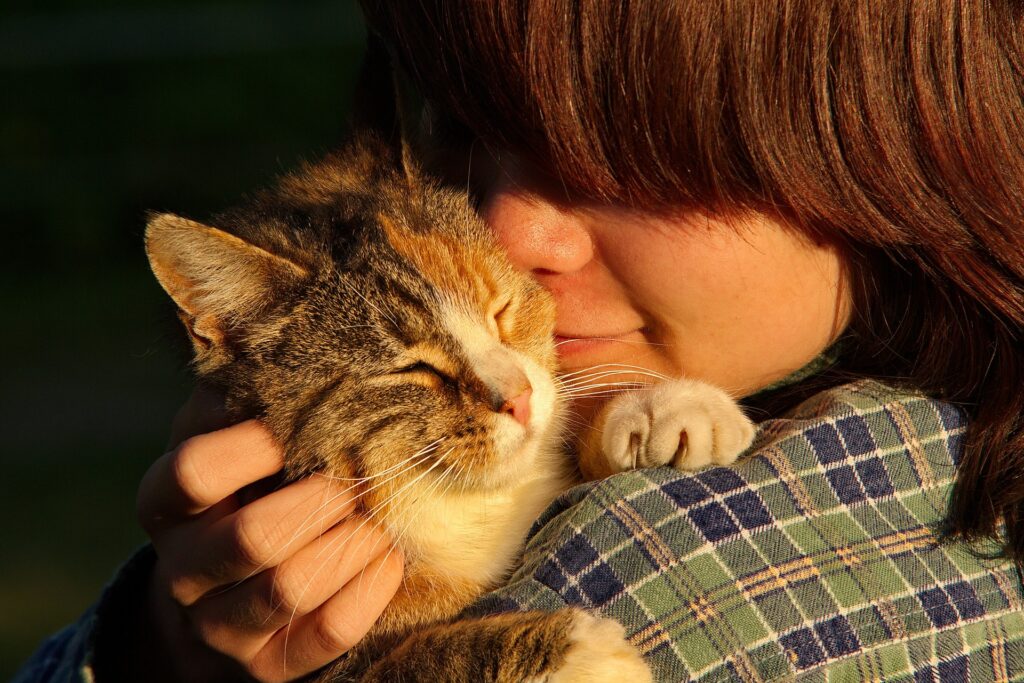Throughout my life growing up, my family always had a cat. I cannot remember any of them being bonded to one particular family member. With one very big exception.
Years ago when my sister had moved to Benton, I picked up a kitten from a nearby barn. Darcy grew up to be a gorgeous domestic long-haired tortie. She was as sweet as she was beautiful. And Darcy was my Mom’s cat, 150 percent.
Mom would sit and relax in the recliner to read the newspaper. And Darcy would promptly jump onto her chest, plopping onto the newspaper, eyes closed and purring loudly. Mom would laugh and say “So much for my reading!” But Mom would gently stroke Darcy’s beautiful long fur and softly smile. This pair was inseparable. Tragically, we lost Darcy at a young age, and my Mom was heartbroken. I want to believe that they are reunited once again.
Cool cats, warm companions
Tail wagging and sometimes protective, dogs have long held the title of man’s best friend. Meanwhile, cats, often silent and solitary, can seem more like man’s aloof and indifferent neighbor. But if you introduce yourself properly, cool cats can become warm companions.
Like dogs, cats have very distinct temperaments and personalities. “Some cats will want to be lap cats and will purr and want to be stroked,” says Barbara J. King, chancellor professor of anthropology at the College of William & Mary and author of Being With Animals. “Some cats want to play but not to be lap cats. Some want to sit near you but not with you. And some are interested in communicating across the room.” The following steps will bring you purrs and head-butts for years to come.
Hello kitty time
Kittens learn key social lessons between 2 and 9 weeks of age, so it’s a perfect time to bond to you and to have contact with other humans, cats, and dogs, in a controlled setting. “Make sure they get a lot of exposure to different types of people and make sure those exposures are insanely positive,” says Jackson Galaxy, a Redondo Beach, Calif., cat behaviorist whose TV mini-series is My Cat From Hell, of which I am a huge fan.
Bonding with a kitten or younger cat depends on the animal’s personality and history. If it has had human contact, it’s likely to be relatively friendly and accustomed to people handling it. Give the kitten a comfortable area to rest, such as a cat bed, and the basics, (meals, treats, toys), and plenty of attention. Some enjoy brushing and grooming, others might not.
If the kitten appears timid or frightened, put it in a bedroom or small room where it will feel safe. Don’t force yourself on the animal. Sit quietly on the floor, read a book, and scatter treats to see if the kitten will come out of hiding. Petting or trying to play might be intimidating at first. But a laser pointer or toy on a long wand might work.
Adopted and rescue cats
When bonding with an adopted cat, knowing its personality can help. Again, give the cat time to explore or restrict it to one room until it’s comfortable. Some cats are confident and will just march into a new house and be totally fine, and others may be terrified and hide.
Figure out if, where and how much the cat likes to be stroked or petted, and when they’ve had enough. Dilated pupils, fur twitches, and a tail that looks like a dog wagging are telltale signs the cat may be over-stimulated and agitated. “If you don’t listen to what your cat is saying, you’re actually doing more harm than good in the bonding arena,” Galaxy says. “It’s really about what they want.”
‘You’re marrying him?’
Cats aren’t big on change. Getting your cat to bond with a roommate or new spouse can be a challenge. Some can be downright aggressive. Cats can have some pretty significant reactions if they move to a new household or if you have a new roommate. Be patient and acclimate the cat slowly. If you’re moving in with someone, take the cat to spend time there in advance. Bring her favorite chair, toys, and scratching post.
If you want the cat to sleep on your bed and both parties agree, go for it. But if you plan to kick the cat off the bed after the initial bonding period, don’t bother. The cat will not understand why it was once ok, and now it is not.
If a roommate or partner is moving in, have the new person take part in activities the cat enjoys, such as regular feedings or playtime with a favorite toy.
Wild things
Bonding with feral or wild cats that have had little or no human contact is difficult, but not impossible. Many have limits on how much they can trust and relax. Speak in a calm, low-pitched, musical voice, avoid sudden movements, and sit on the ground. Instead of staring wide-eyed at a cat, lower your eyelids “like a lazy cat in the sun,” where you mimic them.
In the end, it pays to take time to learn your cat’s like and dislikes. The big payoff is the moment the cat climbs into your lap, looks at you and purrs lovingly when you don’t have food.
Dos and don’ts
Here are more tips on how to make friends with a feline:
- Do be patient. Bonding with a cat, particularly one with a troubled or questionable history, can take a lot of time. Don’t expect the cat to bond equally with every person in the home. Some cats get more attached to a particular person.
- Never raise your voice and don’t spank or swat a cat. “Punishment means nothing to a cat,” Galaxy says. “All you are doing is eroding the bond.” But it’s certainly ok to issue a firm “no” if you catch your cat doing something risky.
- There’s no quick correction for a cat’s aggressive behavior toward a person, but a time-out may work. Safely remove the cat from the situation, putting it in a darkened room where it can calm down. If it’s a new issue with a cat you’ve had for a long time, there may be an underlying medical problem, so check with your veterinarian. Otherwise, a behaviorist can help determine the cause of your cat’s aggression, Galaxy says.
- Don’t leave food out 24/7. “You being the food source is of paramount importance to your cat,” Galaxy says. “If you want to bond with your cat, then you have to be the giver of the food.”
- Do get your cat spayed or neutered. In addition to reducing the unwanted pet population, it tends to even them out and makes them more focused on the type of relationship that you want to have.
- Despite what some may believe, cats do like to be part of the family unit.
- Love, respect, and appreciate your kitties for who they are. In turn, they will give you years of companionship.
Dog bless.
Resource: Pamela Babcock/Pet WebMD

Judy Endo is the author of Paws-itive Pet Tales. A lifelong resident of the Wilkes-Barre area, she has been a professional dog trainer/competitor as well as a lifetime animal lover and strong supporter of animal rescue. Contact: judyendo@outlook.com




